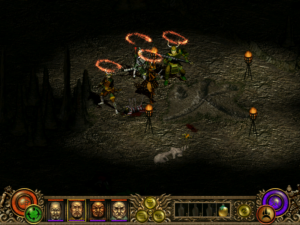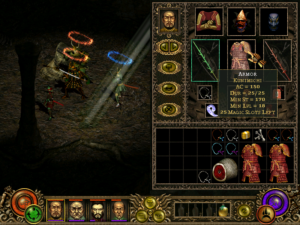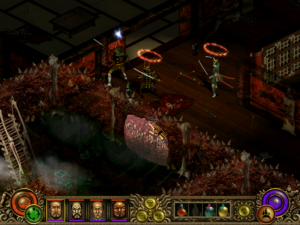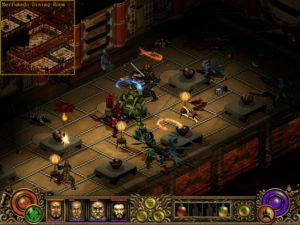Throne of Darkness: The End
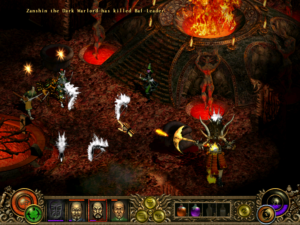 In the end, after you’ve defeated the demonic hordes assembled against you (preferably by using magic to kill them through a wall), it’s just four of you against one oversized demon who can knock you across the room before you get within sword’s reach. Fortunately, you have bows. More to the point, you have a wizard who can summon “dragons”. I put that word in scare quotes because the “dragons” you can summon are nothing like the dragons you fight elsewhere in the game. Instead, they’re basically automated gun turrets in the form of a ghostly dragon head sticking up through the floor. I’ve found that the best way to kill single extremely tough monsters in this game is to lay lots of dragon emplacements as fast as you can and then just run around in circles, adding more dragons as you go: the more you add, the more often the baddie gets hurt. It takes a lot of mana (or ki, as it’s called in this game) to pull this off, but as this is the final confrontation, I figured I may as well buy as many mana potions as I can carry. And so my wizard defeated the demon warlord Zanshin more or less singlehandedly, his companions being there mainly to keep the enemy distracted while I set up the initial dragon array.
In the end, after you’ve defeated the demonic hordes assembled against you (preferably by using magic to kill them through a wall), it’s just four of you against one oversized demon who can knock you across the room before you get within sword’s reach. Fortunately, you have bows. More to the point, you have a wizard who can summon “dragons”. I put that word in scare quotes because the “dragons” you can summon are nothing like the dragons you fight elsewhere in the game. Instead, they’re basically automated gun turrets in the form of a ghostly dragon head sticking up through the floor. I’ve found that the best way to kill single extremely tough monsters in this game is to lay lots of dragon emplacements as fast as you can and then just run around in circles, adding more dragons as you go: the more you add, the more often the baddie gets hurt. It takes a lot of mana (or ki, as it’s called in this game) to pull this off, but as this is the final confrontation, I figured I may as well buy as many mana potions as I can carry. And so my wizard defeated the demon warlord Zanshin more or less singlehandedly, his companions being there mainly to keep the enemy distracted while I set up the initial dragon array.
After that moment of triumph, the final cutscene is a slap in the face. Basically, this is the point where the designers show just how slavisly they’re imitating Diablo. So be warned that I’m about to spoil the endings of both Diablo and Throne of Darkness.
If you’ve played Diablo, you probably remember the shock of the ending. Having defeated the titular demon and locked him back into the crystal he came from, the player character picks up that crystal… and stabs himself in the forehead with it. Which momentarily confuses the player, until you remember enough of the backstory to understand that the hero is binding Diablo’s essence to his own body in order to contain it, making the ultimate sacrifice of becoming a living vessel for the fiend, sealed away underground. It’s a dark, dark ending. There’s no earthly reward for the righteous, and a distinct possibility that the hero is going to eventually crack and let Diablo loose again, beginning the cycle anew.
The creators of Throne of Darkness were clearly aiming for something similar. After you defeat the Dark Warlord, the daimyo of your clan teleports in, takes the Dark Warlord’s sphere of power, and immediately transforms into the new Dark Warlord, turning the seven player characters into his new undead minions. (The final levels contained a “Dark” version of each of the player classes: Dark Swordsman, Dark Archer, etc. Presumably that’s what your team turns into.)
Now, neither of these games is high literature, but the Diablo ending has a bit of tragic depth to it, with the self-sacrifice for the greater good, while the Throne of Darkness ending comes off as no more than cheap irony, and mean-spirited at that. In Diablo, even if you take it that the world is still doomed, at least it’s spared for a while — longer, anyway, than the thirty seconds it takes the daimyo in Throne to render all your efforts pointless. If I had been playing the power-hungry Tokugawa clan, it might have seemed a more appropriate ending, turning into monsters as the ultimate result of placing ambition above all else. But I was playing the lawful-good Mori clan (it was the first one in the list). So the heroes are turned into monsters, not in punishment for their iniquities, or as a result of a tragic flaw, or in an act of self-sacrifice to spare others (as in Diablo), but “just because”.
Still, the final level had its virtues — mainly that, even with the most powerful characters and gear that I could reasonably hope to make, it still required some tactical thought. It’s significant that the monster supply, and thus the XP supply, is actually finite. In an RPG with an infinite XP supply, you have the option of avoiding the more difficult fights until you’re powerful enough to not have to think about them. Even here, I put off the final few castle floors in order to spend time levelling up. It helped, but it didn’t make things trivial. So, good overall balance, even if it did get tedious in the midgame.
 Comments(2)
Comments(2)